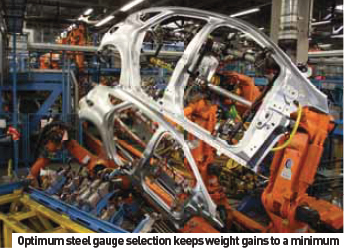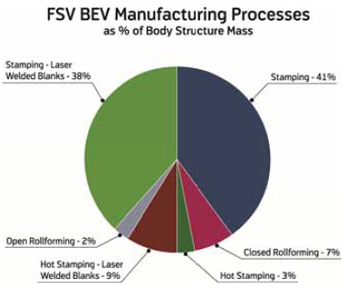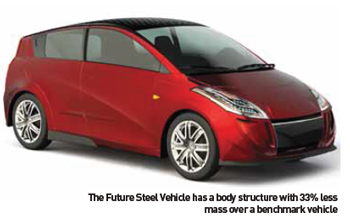The evolution of steel

Aluminium and other exotic materials are being championed as the future of automotive BIW, but Ford and the World AutoSteel organisation believe steel will remain the material of choice, albeit in non-traditional forms.
At a recent model launch, a sheet was pulled back to reveal a new sports car. After the applause died down, the gathered attendees split into groups, each concerned with uncovering specific details about the new car.
In an engineering session, a lead designer for the project was asked about how exotic materials would be used in the car. The reply outlined the fact that this near-production prototype had a steel body, at which point half the audience lost interest.
It’s an odd thing to witness. In most industries a material that’s flexible, formable, strong and recyclable is lauded, but in the modern era of automotive design, steel tends to be viewed as singularly uninspiring. It’s a matter of perception - if the future demands lightweight body structures with improved crash protection and better ride and NVH performance, how can it rely on the same material that has been the bedrock of the industry for the last century? It’s a case of asking the wrong question. Rather than being a single product, ‘steel’ is a catchall for a family of materials from which automotive body parts are manufactured through a wide variety of processes, ultimately brought together using a variety of joining techniques. It has a better record for innovation than the exotics that capture public imagination, with the added advantage of being both affordable and practical.
 On the subject of innovation, Ford’s latest C-segment platform is a case-in-point, as Thomas Müller, European body structures manager, explains: “In the previous generation of our C-segment cars, approximately 10% of the body structure was formed from very high strength steel grades. In our latest version, which began to launch at the end of 2010, at least 30% of the structure uses very high strength steels.”
On the subject of innovation, Ford’s latest C-segment platform is a case-in-point, as Thomas Müller, European body structures manager, explains: “In the previous generation of our C-segment cars, approximately 10% of the body structure was formed from very high strength steel grades. In our latest version, which began to launch at the end of 2010, at least 30% of the structure uses very high strength steels.”
By definition, the very/ultra-high strength steels to which Müller refers include dual phase materials, aluminiumcoated boron steels and martensitic grades. The latter is being used for the first time by Ford Europe, the material roll-formed to create a rocker reinforcement.
The new platform, as the name suggests, is reuniting Ford’s disparate C-segment vehicles from around the world, with the Saarlouis plant in Germany continuing to produce the European version of the Ford Focus. When Ford launched the second-generation Focus in 2004 it was stiffer than its predecessor, but also significantly heavier. While the third generation is stiffer again, the improvement does not come with an added weight penalty; a statistic that Müller suggests is heavily dependent on the use of more advanced materials in body construction.
“There was a requirement to reverse the historic trend of increasing mass in the body-in-white that we’ve seen over the last ten or fifteen years. But at the same time, we still needed to provide ever-improving levels of performance: We needed a stiffer vehicle; we needed a vehicle that met ever increasing demands for safety; and we needed to do that without making the vehicle heavier.”
The challenges of improving crash worthiness and stiffness performance are not obviously compatible with a weight reduction programme and given the premium attached to safety, the battleground for vehicle design is always going to be in producing a stiffer, product-differentiating chassis. One side-effect of using stronger, thinner material sections is the naturally detrimental effect it has on vehicle stiffness, which required Ford to employ a little creative thinking.
“As we down-gauge and use less material there’s an immediate effect on the stiffness of a body structure. We knew it would hurt our stiffness performance target,” says Müller. “To offset that we have to be clever with our design. We’ve improved joining positions in some instances, but we’ve also used technologies that allow us to incorporate thickness changes into materials. We’ve made more use of tailor-welded blanks and tailor rolling, which we see on the B-pillar reinforcement of the new Focus, or, as we have on the C-MAX, a patch-welded blank – essentially a tailormade assembly of two blanks which are stamped together in one process as if they were one part.”
 Migrating to a greater percentage of ultra-high strength steel did not fundamentally change the operation of the bodyshop at Saarlouis, other than requiring an upgrade to mid-frequency welding equipment to ensure a more robust process. It is, however, undeniable that the change of materials comes with a cost penalty. Yet Müller is confident that Ford’s CAE verification process will allow it to claw most of that back through efficiency savings. More expensive materials, but less material overall.
Migrating to a greater percentage of ultra-high strength steel did not fundamentally change the operation of the bodyshop at Saarlouis, other than requiring an upgrade to mid-frequency welding equipment to ensure a more robust process. It is, however, undeniable that the change of materials comes with a cost penalty. Yet Müller is confident that Ford’s CAE verification process will allow it to claw most of that back through efficiency savings. More expensive materials, but less material overall.
“The ultra-high strength materials we have specified do come at a price, but we’re aiming to offset the cost increases seen in the specific parts by having more efficient designs. We have an increased capability to predict our attribute performance parameters, so we’re able to get closer and closer to an optimum gauge selection, which for us means having the exact gauge that delivers the performance but not one-hundredth of a millimetre more. Putting less weight into the vehicle means you use less material in producing the cars, which saves a big chunk of money.”
While the third-generation Focus and its siblings are at the forefront of contemporary design, a better indicator of the automotive future might be seen in a car sharing their name and platform. The Ford Focus BEV, was first shown at the 2009 Frankfurt Motor Show. Renamed the Focus Electric for 2011, and rolled-out with a 23kWh lithium-ion battery pack and a 100kW electric motor, the EV has a nominal range of around 100 miles.
Interestingly, the Focus Electric shares the glider of its mainstream sibling, using little beyond the minimum adaptation required to replace the IC powertrain with the electric equivalent. However, a study by WorldAutoSteel, the automotive wing of the World Steel Association, suggests a bespoke body for electric vehicles has the potential to cut considerable weight.
 WorldAutoSteel has recently completed a three-year programme titled FutureSteelVehicle (FSV), the headline findings of which were the potential to create a body structure with a 35% mass reduction compared to a benchmark vehicle. It would be capable of meeting all the relevant crash requirements, while reducing total lifecycle emissions by nearly 70% (in some markets), without manufacturing cost penalties. Reflecting the fact that the market for alternative-fuel vehicles tends to look beyond headline figures, FSV doesn’t simply consider the potential effect on turbine-to-tailpipe emissions of its structure, but arrives at its conclusions after a carbon footprint audit based upon a lifecycle analysis methodology that included manufacturing energy expenditure and recycling potential in its figures.
WorldAutoSteel has recently completed a three-year programme titled FutureSteelVehicle (FSV), the headline findings of which were the potential to create a body structure with a 35% mass reduction compared to a benchmark vehicle. It would be capable of meeting all the relevant crash requirements, while reducing total lifecycle emissions by nearly 70% (in some markets), without manufacturing cost penalties. Reflecting the fact that the market for alternative-fuel vehicles tends to look beyond headline figures, FSV doesn’t simply consider the potential effect on turbine-to-tailpipe emissions of its structure, but arrives at its conclusions after a carbon footprint audit based upon a lifecycle analysis methodology that included manufacturing energy expenditure and recycling potential in its figures.
WorldAutoSteel Director Cees ten Broek explains the thinking behind the consortium’s decision to go electric: “Since 1995 when we started with the Ultra-Light Steel Auto Body (ULSAB), WorldAutoSteel has been demonstrating how advanced high-strength steels can deliver substantial mass reduction while adhering to the latest safety standards.
But before FSV, all our programmes were based around vehicles with an IC engine because we always wanted to compare what could be done against the cars on the road today. This time we wanted to look at alternative powertrains because we wanted to highlight how steel’s innovative capabilities would relate to the manufacture of future car bodies. There’s also now a requirement for materials suppliers to be responsible for assessing the carbon footprint of the materials they supply and we felt it would be useful to gather data on that as well.”
It’s a smart move for WorldAutoSteel. For many, the idea of delivering an alternative powertrain is inseparable from the development of an alternative chassis, which frequently involves a greater concentration of exotic materials than is strictly practical. FSV seeks to champion the case for an alternative body structure that uses conventional forming and joining technology, using steel grades currently in circulation.
“When we started FSV, all the steel grades we included in the study were either commercially available or in development, with anticipated arrival on the open market during the 2015-2020 timeframe covered by the study,” explains WorldAutoSteel technical consultant George Coates. “What’s interesting is, looking at the grades that were available to ULSAB, there was only one in the gigapascal range. Looking at FSV, you’ll see a lot of grades that achieve gigapascal strength levels.”
The FSV programme included over 20 ultra-high strength steel grades, including dual-phase, transformation-induced plasticity (TRIP), twinning-induced plasticity (TWIP), complex phase and hot-formed steels. WorldAutoSteel took its own ULSAB body as the benchmark, adjusted for a battery-electric powertrain and projected 2020 regulatory requirements. Combining the new materials, best manufacturing practice and a fairly aggressive design optimisation process, FSV came up with a concept body weighing 188kg – 97% of which is assembled from highstrength or ultra-high strength steel grades, and over half of which uses grades with a tensile strength in the gigapascal range. It would, however, require only conventional assembly and forming technologies, a factor which supports FSV’s claim that, for a vehicle programme manufacturing 225,000 units a year, it could match it’s benchmark total body cost of $1,115 (€770) per unit.
“There’s really nothing unique about the body structure assembly line, compared to conventional series production plants today,” confirms senior WorldAutoSteel advisor Ed Opbroek. “We might see more continuous laser welding than is common in a typical assembly plant but it’s technology that’s well established.
“In terms of fabrication, FSV demands a lot of pressstamped parts and a high percentage of laser-welded blank stamping parts, What is perhaps unique is the amount of hot-stamping we envisage. Again, it’s not a new technology, but FSV calls for approximately 12% of the body structure to be hot-stamped, which is pushing the envelope a little. We’re always trying to reduce weight by maximising strength and minimising the thickness of parts, and hot stamping works quite well for that.”
The FSV engineers suggest their finished design involves many ‘non-intuitive’ shapes as a product of a CAE designoptimisation process tasked with driving every superfluous gram out of the structure. They argue that, while every automotive design group will use the same tools, FSV is able to achieve better results by not being bound by historical precedent.
 “What you get in the automotive community is a great temptation to say ‘we did it this way in the past and it worked pretty well, let’s start from there’,” says Coates. “In contrast, we wanted to start without that engineering bias.
“What you get in the automotive community is a great temptation to say ‘we did it this way in the past and it worked pretty well, let’s start from there’,” says Coates. “In contrast, we wanted to start without that engineering bias.
As a result, we achieved non-intuitive shapes that sometimes take crash-load paths in directions we didn’t anticipate – and those shapes in turn drive the fabrication requirements. We ended up with more stampings than we were expecting and maybe fewer roll-formed parts because of the geometries involved, but hot-stamping became a really favourable manufacturing option because of the intricate shapes and high strengths we required.
“The design optimisation software could pick the grades and the forming technologies and the manufacturing techniques – all we were required to bring was an open mind. It meant we ended up with sections that looked strange compared to what our experience told us to expect, but they were the lowest weight sections that met the performance criteria we had defined.”
Undoubtedly structures similar to FSV will see their own unveiling at future motorshows, though how many of them make it to the showroom is a different question. Most carmakers are betting on electric vehicles having an impact, although as the limiting factor of battery energy storage is not going to simply vanish, quite how big an impact will remain a guessing game over the short to medium term.
With its recent advances, it is much more likely that steel will remain the material of choice in automotive BIW. FSV’s senior management says that, while the design optimisation would change, their basic research is perfectly valid for use with IC engines, given that it draws upon manufacturing techniques and steel grades already used within the industry. They also point out that even more advanced grades, advertising tensile strengths up to 1900MPa, are now beginning to appear, offering the potential for performance that supersedes their designs. It isn’t the sort of breakthrough liable to excite a launch crowd, but in terms of a convenient solution to a particularly difficult engineering problem, steel looks like it isn’t going to relinquish its hold on the industry any time soon.
Rather than approaching the weight-reduction exercise for the new C-platform on a part-by-part basis, Ford engineers looked at the project holistically, running through a series of design loops, intended to gradually take weight out of the structure by studying the interaction of parts and using this for their material and forming choices. Thomas Müller, Ford’s European body structures manager, explains the process:
“The initial design was based on a range of targets developed by our internal benchmarking, as well as considerable external benchmarking. It included an extensive set of weight targets for the body structure, plus parameters for overall stiffness of the body-in-white and many stiffness targets for local attachment areas for chassis and powertrain. “Our core technology team started the development [process] with something we call a ‘first pick-list’, which lists a preferred material and an exact grade as the starting point for the gauge of each part in the body structure. From there we went through various loops of design where CAE verification refines grades and gauges distribution of materials within the body structure.
“In terms of the steel we use, martensite has very high yield strength and ultimate tensile strength. It can only be roll-formed – but using it in combination with a roll-forming process allows us to have very efficient designs because the process has a very high material utilisation in terms of the net-weight of the part versus the blank weight. “Boron steels are similar. We only use aluminium-coated boron steel, and again the advantages of the hybrid are very high yield strength and ultimate tensile strength, while also being very formable. With boron steel we have more freedom with dimensions, the only downside is that the material is specifically linked to the hot-forming process, which therefore requires a little bit more effort in terms of tool design, tool layout and cost. It also needs post-forming attention such as laser trimming, which obviously also represents higher effort and higher cost.
“That is avoidable if we go back to dual-phase materials where we have a good compromise of high-strength material properties – not as high as the previous two groups of materials but with benefits of very efficient high-volume use, specifically a very high parts-per-minute throughput in the stamping process.”


